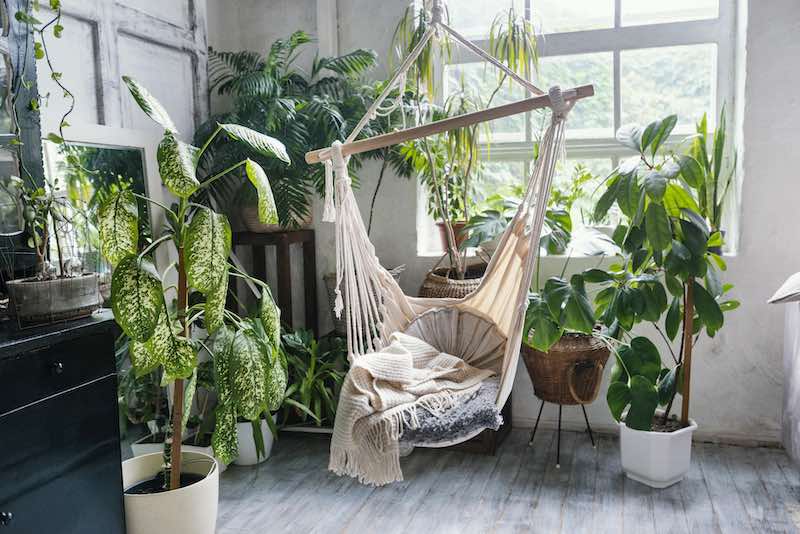
Do you love nature and want to bring more of it into your home? Are you more relaxed and happy surrounded by plants, animals, and natural materials?
If so, you might be interested in biophilic design, a popular trend among homeowners who want to create a more harmonious and healthy living environment.
Biophilic design incorporates natural elements into the built environment, such as indoor plants, natural light, organic shapes, textures, and colors. Biophilia means “love of life” and reflects the human instinct to connect with nature.
Research has shown biophilic design can benefit our well-being by reducing stress, improving mood, enhancing creativity, and boosting productivity.
This blog post will show you how to embrace biophilic design in your home and create a tranquil oasis that will make you feel closer to nature.
We will cover the following topics:
>The principles of biophilic design
>The benefits of biophilic design for your health and happiness
>The best ways to incorporate biophilic design into your home
>Some inspiring examples of biophilic design in action
Let’s get started!
The Principles of Biophilic Design
Biophilic design is based on the idea that humans have an innate affinity for nature and must maintain a connection with it to thrive.
According to biophilic design expert Stephen Kellert, there are three major categories of biophilic design:
Direct experience of nature
This involves bringing actual natural elements into the space, such as plants, water, animals, natural light, fresh air, and sounds. Examples include indoor gardens, aquariums, skylights, windows, fountains, and bird feeders.
Indirect experience of nature
This involves using natural materials, colors, shapes, patterns, and images that evoke nature. Examples include wood, stone, metal, clay, wool, cotton, leather, green walls, floral prints, animal motifs, and landscape paintings.
Experience of space and place
This involves creating a sense of spatial harmony, orientation, and belonging in the room. Examples include open floor plans, curved walls, high ceilings, views of the outdoors, and cozy nooks.
The Benefits of Biophilic Design for Your Health and Happiness
Biophilic design is aesthetically pleasing and beneficial for your physical and mental health.
Studies have found that biophilic design can:
- Reduce stress and anxiety: Exposure to nature can lower blood pressure, heart rate, cortisol levels, and muscle tension. It can also increase the production of serotonin and dopamine, the hormones that make us feel good.
- Improve mood and cognition: Exposure to nature can enhance mood, memory, attention span, creativity, and problem-solving skills. It can also reduce depression, fatigue, and boredom.
- Boost productivity and performance: Exposure to nature can improve concentration, motivation, and efficiency. It can also reduce absenteeism, turnover, and errors.
- Support immune system and healing: Exposure to nature can stimulate the immune system, reduce inflammation, and promote healing. It can also reduce pain, nausea, and medication use.
The Best Ways to Incorporate Biophilic Design into Your Home
If you want to create a tranquil home oasis with a biophilic design, here are some tips to follow:
Tip #1: Start with plants
Plants are the easiest and most effective way to bring nature into your home. They can purify the air, add color and texture, and create a soothing ambiance. You can choose from various indoor plants that suit your style and needs, such as succulents, ferns, orchids, herbs, or bonsai trees.
You can also arrange them in different ways, such as hanging baskets, terrariums, pots, or shelves.
Tip #2: Let in natural light
Natural light is essential for health and happiness. It can regulate our circadian rhythms, improve our mood and energy levels, and enhance our perception of space. You can maximize natural light in your home by using large windows, skylights, mirrors, and sheer curtains.
You can also use artificial lighting that mimics natural light, such as LED bulbs or dimmed lamps.
Tip #3: Use natural materials
Natural materials can add warmth, texture, and character to your home. They can also create a sense of connection with the earth and its resources.
You can use natural materials such as wood, stone, metal, clay, wool, cotton, leather, or silk for your furniture, flooring, walls, ceilings, or accessories. You can also mix and match different materials to create contrast and interest.
Tip #4: Add natural colors
Natural colors can create a calming and harmonious atmosphere in your home.
They can also reflect your personal preferences and moods. You can use natural colors such as green, blue, brown, beige, white, or gray for your walls, furniture, or textiles.
You can also add pops of color with accents, such as pillows, rugs, artwork, or flowers.
Tip #5: Incorporate natural shapes and patterns
Natural shapes and patterns can add visual interest and dynamism to your home.
They can also stimulate our senses and imagination. You can incorporate natural shapes and patterns such as curves, spirals, waves, fractals, or stripes for your furniture, walls, ceilings, or accessories.
You can also use geometric shapes and patterns inspired by nature, such as hexagons, triangles, or circles.
Tip #6: Display natural images and artwork
Natural images and paintings can create a sense of beauty and wonder in your home.
They can inspire and remind you of your favorite places and experiences. You can display natural images and artworks such as paintings, drawings, sculptures, or collages of landscapes, animals, plants, or people.
You can also use personal items that have sentimental value or meaning for you, such as souvenirs, postcards, or shells.
Tip #7: Create a sense of space and place
Creating a sense of freedom and place can make your home more comfortable and inviting.
It can also help you organize and optimize your space according to your needs and preferences.
You can create a sense of space and place by using open floor plans that allow for flexibility and interaction, curved walls that create a feeling of enclosure and intimacy, high ceilings that make a feeling of spaciousness and freedom, views of the outdoors that generate a sense of connection and continuity, and cozy nooks that create a feeling of privacy and relaxation.
Some Inspiring Examples of Biophilic Design in Action
If you need some inspiration for your biophilic design project, here are some examples of homes that have successfully incorporated biophilic design elements:
A modern loft with an indoor garden
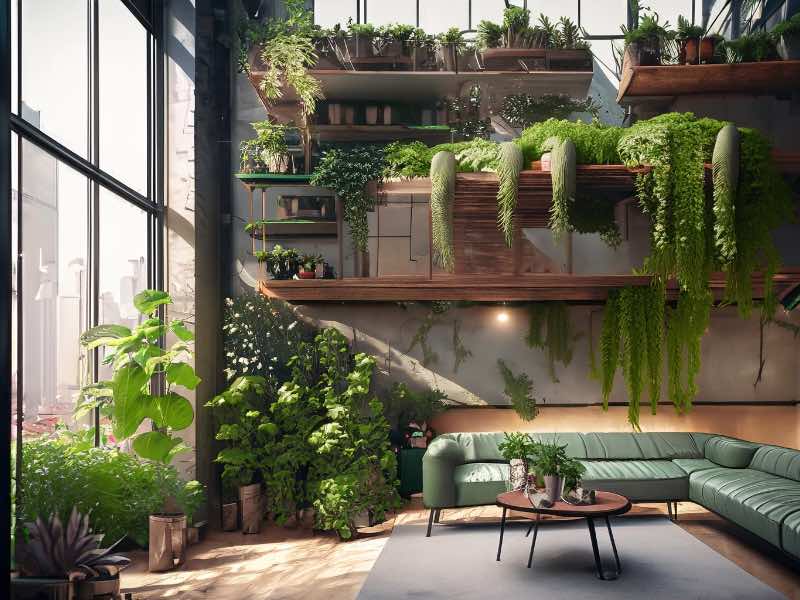
This loft in New York City features an indoor garden that covers an entire wall with plants of different sizes, shapes, and colors. The garden adds life and freshness to the space and is a natural air filter and sound barrier.
A rustic cabin with a stone fireplace
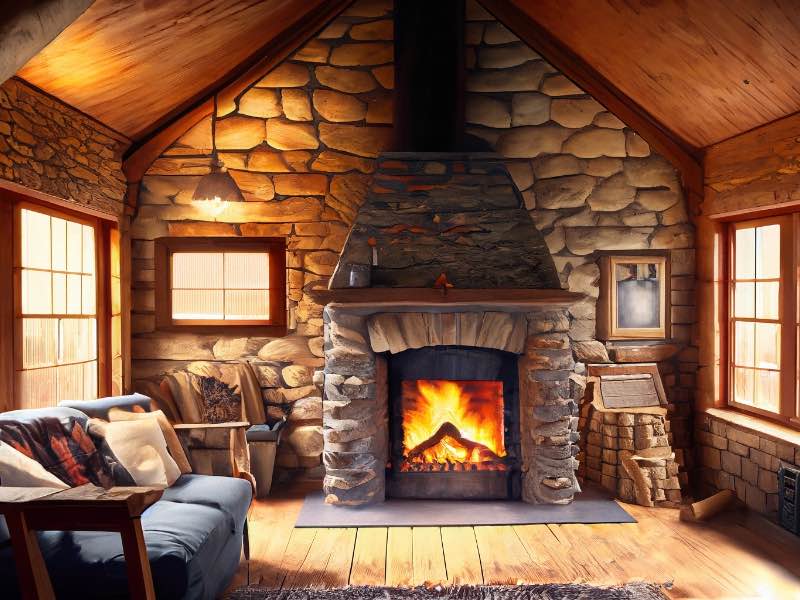
This cabin in Colorado features a stone fireplace that dominates the living room with its natural texture and warmth. The fireplace provides heat and light and creates a focal point and a cozy atmosphere.
A minimalist apartment with a skylight
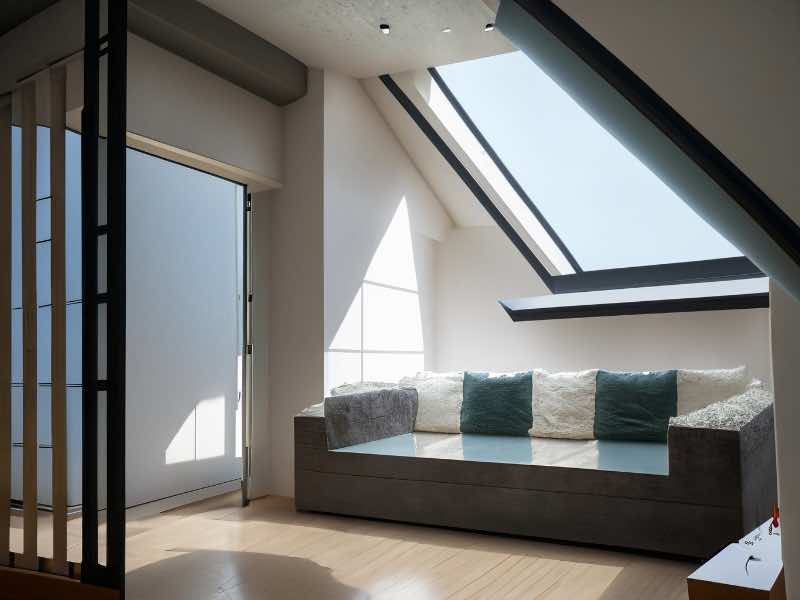
This apartment in Tokyo features a skylight that fills the space with natural light and sky views. The skylight not only brightens up the area but also creates a sense of openness and elevation.
A tropical villa with a water feature

This villa in Bali features a water feature that runs through the center of the house with a bridge over it. The water feature adds movement and sound to the space, creating a cooling effect and a zen vibe.
A cozy cottage with a floral wallpaper
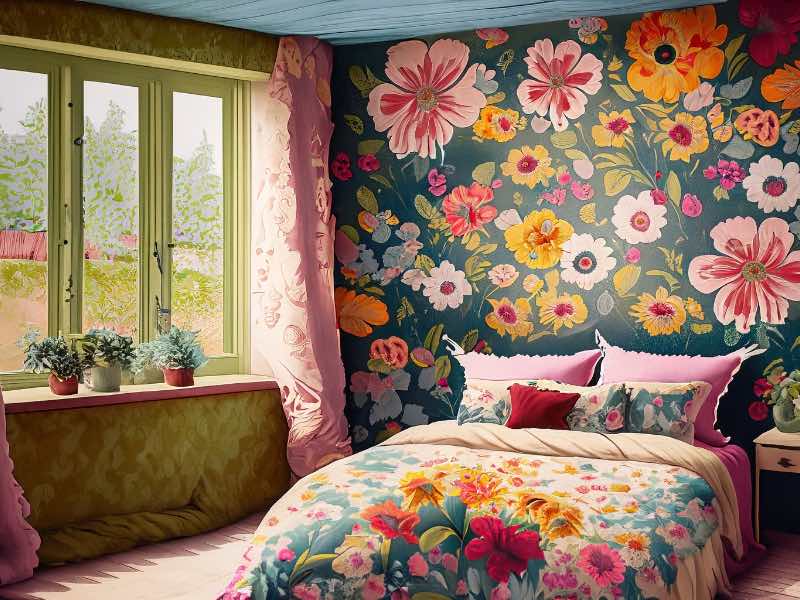
This cottage in England features a floral wallpaper that covers the bedroom walls with vibrant colors and patterns. The wallpaper adds charm and personality to the space and creates a cheerful and romantic mood.
Final Thoughts About Biophilic Design
Biophilic design is a trend that can help you create a tranquil home oasis with nature. Incorporating natural elements into your home can improve your health, happiness, productivity, and creativity. You can also express your style, taste, and values.
Biophilic design is relatively easy to achieve. You must follow some simple principles, such as bringing in plants, letting in natural light, using natural materials, adding natural colors, incorporating natural shapes and patterns, displaying natural images and artworks, and creating a sense of space and place.
You don’t need to overhaul your entire home to embrace biophilic design. You can start small by adding plants, changing lighting, or hanging artwork and experimenting with elements, combinations, and arrangements to find the best.
Biophilic design is not only good for you but also good for the planet. By using natural resources wisely, reducing waste, and supporting biodiversity, you can contribute to preserving and restoring nature.
Are you ready to try biophilic design in your home? Let us know what you think in the comments below!